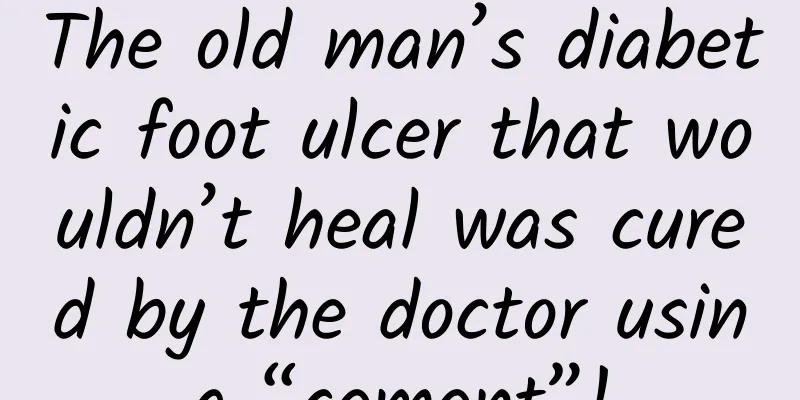The old man’s diabetic foot ulcer that wouldn’t heal was cured by the doctor using “cement”!

|
On November 9, it was time for Grandpa Liu to change the dressing. The 71-year-old grandfather breathed a sigh of relief when he saw the skin on his feet slowly healing! After his ulcerated and smelly feet were cured at Yueyang County People's Hospital , Grandpa Liu had a smile on his face and kept saying from the bottom of his heart: The department has great technology and Doctor Zou is amazing! More than two months ago, Grandpa Liu, who had been suffering from diabetes for nearly 10 years, had his right foot crushed, and a large piece of skin on the instep was torn and fell off. He was treated at the Department of Neurospine and Hand Surgery of Yueyang County People's Hospital, and after initial debridement and suturing, the wound was treated with autologous skin grafting. If he were not a diabetic, the wound would not be difficult to heal. However, years of diabetes have caused certain obstructions to the blood vessels, nerves, and microcirculation in Grandpa Liu's feet, making it difficult for blood and nutrients to reach the wound. Although he has actively taken anti-inflammatory and anti-infection measures, the wound has never been completely healed. This has caused Grandpa Liu and his family a lot of headaches and made it difficult for them to smile. After communicating with the patient and his family, the attending physician, Associate Chief Physician Zou Liang , decided to use a special cement to repair the wound! After the necrotic tissue and pus are sucked out by negative pressure drainage (VSD), the growth of granulation tissue on the wound surface is promoted, creating conditions for placing "cement". After a few days of drainage, the wound surface is dry and bleeding-free, and a large amount of granulation tissue can be seen growing, which is ready for "cement". After debridement, bone cement mixed with antibiotics is prepared into a plasticine-like shape and evenly covered on the wound surface. Zou Liang, deputy chief physician, introduced: The application of antibiotic bone cement in chronic wound repair and diabetic foot is a new technology in recent years . The wound is filled, covered and isolated, which can protect the bone, tendon and other soft tissues of the wound while inducing the formation of its own biofilm. At the same time, the wound is directly medicated, and the antibiotic concentration can reach dozens of times that of intravenous administration, and the release period is as long as more than 3 weeks , which can effectively control wound infection and promote wound healing. After covering it with this "cement", Grandpa Liu was surprised to find that his right foot, which was painful before and he dared not move at all, could actually walk. This is amazing! Grandpa, who had hardly smiled since the injury, couldn't help but smile, very happy... After continuing to lower blood sugar, anticoagulant, reduce swelling and relieve pain, Grandpa Liu was discharged from the hospital with "cement". The doctor advised him to control his blood sugar at home and after resting for a period of time, he could undergo skin grafting depending on the recovery of the wound. On October 25, the wound recovered well during the follow-up examination, and the Neurospine and Hand Surgery Department continued to perform autologous abdominal skin harvesting + wound skin grafting surgery on Grandpa Liu. The magical "cement" praised by Grandpa Liu is actually bone cement, an orthopedic medical material. Because its appearance and properties are quite similar to the white cement used in building decoration, it is commonly called "bone cement". Bone cement mixed with antibiotics has achieved very good results in the treatment of difficult-to-heal chronic wounds of diabetic foot in recent years due to its high mechanical strength, good bone conductivity and long-lasting anti-infection ability. Traditional diabetic foot wounds are difficult to heal and require multiple debridement and anti-inflammatory treatments, which are long and expensive. There is also a risk of amputation due to poor long-term infection control. Antibiotic bone cement membrane induction surgery has greatly reduced the amputation rate of diabetic foot patients, reduced hospitalization costs, shortened hospitalization cycles, and has significant efficacy. It is a very cost-effective treatment method. Source: Department of Neurospine and Hand Surgery, Yueyang County People's Hospital Follow @湖南医聊 to get more health science information! (Edited by YT) |
Recommend
Can I drink bayberry wine during menstruation?
Menstruation is very important to women and shoul...
What injection should I take for mastitis?
Many new mothers will suffer from mastitis while ...
White discharge after sex
Some women bleed after intercourse. This phenomen...
Liquid-based cytology test
Because the traditional acid-fast staining method...
How to "cover" in spring
"Don't take off your cotton clothes in F...
What are some tips for making your breasts bigger?
Asian women have small breasts on average, so som...
What does cervical separation mean in pregnant women?
The female cervical canal is actually the channel...
Should I get pregnant again 3 months after a caesarean section?
Clinically, the main modes of delivery include na...
Can I have blood drawn for testing during my period? Why do I have to draw blood from my ring finger?
Some tests require blood tests. So for girls, can...
Five foods women need throughout their lives
Yogurt, moisturizes the intestines and supplement...
What foods should we eat to maintain health during the Autumnal Equinox? What flowers are there during the Autumnal Equinox?
During the autumnal equinox, most parts of my cou...
What are the characteristics of the pulse in early pregnancy?
In ancient times, women usually judged whether th...
Visible cervical blood vessels
Cervicitis is a common disease among women of chi...
Where does the amniotic fluid come from?
In the late pregnancy, when delivery is about to ...
If you look at your phone or computer for a long time, you may develop strabismus?
Recently, our hospital has received more and more...









